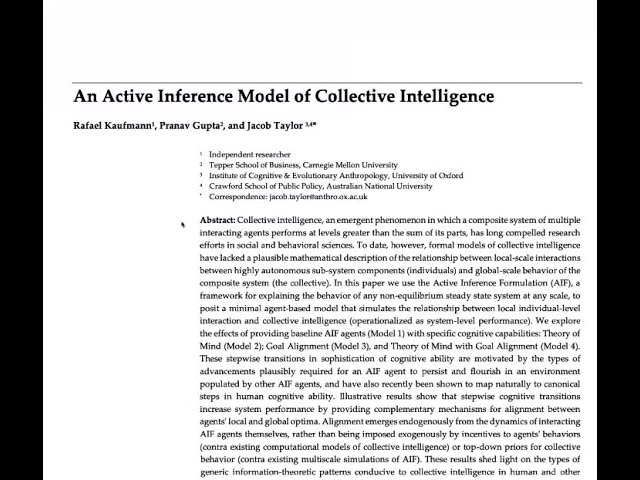
Unveiling Collective Intelligence: Insights from Active Inference Modeling
In today’s rapidly evolving world, the concept of collective intelligence is becoming increasingly important. Whether in technology, organizational behavior, or even complex systems like economics and healthcare, the ability to harness the intelligence of a group is a key factor in success. Recently, an insightful discussion led by R. Kaufman, P. Gupta, and J. Taylor explored this topic through the lens of active inference modeling, providing valuable insights into how we can better understand and improve collective intelligence.
The Genesis of Collective Intelligence
The research presented in this discussion has its roots in Kaufman’s experience at Google, where he worked on enhancing organizational effectiveness within Alphabet—a complex ecosystem of engineers, product managers, and finance professionals. With a background in mathematics, Kaufman approached this challenge by developing mathematical models aimed at improving the collective intelligence of such a vast and diverse organization.
During his time at Google, Kaufman became intrigued by the potential of active inference as a framework for modeling intelligent behavior in complex systems. Active inference, a concept grounded in the Bayesian brain hypothesis, offers a way to formalize the relationship between local interactions among agents and the higher-level behavior of the collective. This approach resonated with Kaufman’s goals and led to the collaborative research that culminated in this discussion.
Active Inference and Its Role in Collective Intelligence
At the heart of this research lies the principle of active inference, which provides a natural framework for interpreting behaviors within a system. Active inference models intelligent behavior as a process of minimizing free energy—a concept that can be applied to various domains, including collective intelligence.
The researchers aimed to formalize collective intelligence by exploring how local-scale interactions among agents (e.g., individuals in an organization) translate into intelligent behavior at the collective level. By augmenting traditional agent models with capabilities like theory of mind and goal alignment, they sought to understand how these factors influence the overall performance of the collective.
Theory of Mind and Goal Alignment: The Building Blocks of Collective Intelligence
Two key capabilities were central to this research: theory of mind and goal alignment.
Theory of mind refers to an agent’s ability to model and predict the behavior of others within the system. This capability is crucial in environments where agents must collaborate or compete with one another, as it allows them to anticipate and respond to the actions of others effectively.
Goal alignment, on the other hand, is the degree to which agents within a collective share and pursue common goals. In many organizational contexts, achieving goal alignment is essential for ensuring that all members are working towards the same objectives, thereby enhancing the collective’s overall performance.
The researchers hypothesized that both theory of mind and goal alignment would improve the collective’s performance. However, their findings revealed something even more interesting: the combination of these two capabilities is crucial. While each capability independently contributes to better performance, it is their synergy that truly elevates the collective’s ability to function intelligently.
For example, in simulations, agents with both strong theory of mind and goal alignment outperformed those with just one of these capabilities. The research also highlighted a “Goldilocks effect” with theory of mind—too much could lead to a “blind leading the blind” scenario, particularly in ambiguous environments. This finding underscores the importance of balancing these capabilities to achieve optimal collective intelligence.
Implications for Organizational Effectiveness
The implications of this research extend far beyond theoretical modeling—they offer practical insights for organizational management. In today’s fast-paced, dynamic environments, organizations must coordinate diverse teams of specialists who must work together effectively under uncertainty. The principles of collective intelligence, as explored through active inference, provide a framework for achieving this coordination.
One of the most compelling analogies discussed is that of flocking behavior in birds, which illustrates how decentralized control and local interactions can lead to emergent, intelligent behavior at the collective level. Just as birds follow simple rules to achieve complex flocking patterns, individuals within an organization can follow rules that promote effective coordination and collaboration, leading to superior collective outcomes.
Future Directions and Applications
As the discussion unfolded, it became clear that the potential applications of this research are vast. Kaufman, for instance, has taken these ideas into new territories, including modeling economic agents, assessing climate risk, and even exploring safety in autonomous vehicle fleets. The principles of active inference and collective intelligence are proving valuable in diverse fields, from finance to fisheries management.
Moreover, these insights are not limited to human organizations. As AI and machine learning continue to evolve, the principles of collective intelligence will play a crucial role in ensuring that autonomous systems, like fleets of robots or AI-driven financial networks, operate safely and effectively.
Conclusion
The exploration of collective intelligence through active inference modeling, as presented by R. Kaufman, P. Gupta, and J. Taylor, offers a profound understanding of how intelligent behavior emerges from the interactions of agents within a system. By combining capabilities like theory of mind and goal alignment, we can unlock new levels of performance and coordination in both human and machine-based collectives.
As we move forward, it is essential to continue exploring these ideas, applying them in various domains, and refining our understanding of how collective intelligence can be harnessed to address the complex challenges of our time.
Call to Action
What are your thoughts on collective intelligence and its applications? How do you see these principles being applied in your field or organization? Share your insights in the comments below, and explore more about active inference and collective intelligence through the links provided.







